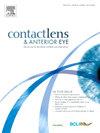Effect of 0.01% atropine eye drops combined with different optical treatments to control low myopia in Chinese children
IF 3.7
3区 医学
Q1 OPHTHALMOLOGY
引用次数: 0
Abstract
Purpose
To investigate the efficacy and safety of 0.01% atropine (AT) in combination with different optical treatments for controlling myopia in Chinese children.
Methods
This retrospective study analyzed 341 Chinese children aged 6–11 years with myopia between −0.50 D and −3.0 D between January 2022 and May 2023. The fast-progressing, myopic children received three optical treatments combined with 0.01 % atropine: 75 children with single-vision spectacles and atropine (SV + AT), 162 children with defocus-incorporated multi-segment spectacles and atropine (DIMS + AT), or 104 children with orthokeratology and atropine (OK + AT). The changes in spherical equivalent refraction (SER), axial length (AL), intraocular pressure (IOP), and amplitude of accommodation (AMP) were observed at 6-month and 1-year intervals.
Results
After controlling for baseline variables, at 6 months, the increase in adjusted AL was significantly greater in the SV + AT group than in the DIMS + AT group (difference = 0.13 mm, 95 % CI: 0.07–0.20, P < 0.05) and in the OK + AT group (difference = 0.09 mm, 95 % CI: 0.09–0.17, P < 0.05). A more significant progression in adjusted SER was also observed in the SV + AT group than in the DIMS group (difference = −0.20D, 95 % CI: −0.29 to −0.11, P < 0.05). At 12 months, the greatest increase in adjusted AL was observed in the SV + AT group, with a statistically significant difference of 0.24 mm (95 % CI: 0.19–0.29, P < 0.05) compared with the DIMS group and a difference of 0.19 mm (95 % CI: 0.13–0.25, P < 0.05) compared with the OK + ST group. Similarly, a more significant progression in adjusted SER was observed in the SV + AT group than in the DIMS group (difference = −0.36 D, 95 % CI: −0.48 to −0.24, P < 0.05).
Conclusions
This study suggested that 0.01% atropine combined with DIMS or orthokeratology may be viable for controlling low myopia in fast-progressing, myopic children.
0.01% 阿托品滴眼液联合不同光学疗法控制中国儿童低度近视的效果。
目的:探讨0.01%阿托品(AT)联合不同光学疗法控制中国儿童近视的有效性和安全性:这项回顾性研究分析了 2022 年 1 月至 2023 年 5 月间 341 名近视度数在-0.50 D 至-3.0 D 之间的 6-11 岁中国儿童。这些近视度数进展较快的儿童接受了三种光学治疗和 0.01 % 阿托品治疗:75 名儿童接受了单光眼镜和阿托品治疗(SV + AT),162 名儿童接受了散焦入射多片式眼镜和阿托品治疗(DIMS + AT),或 104 名儿童接受了角膜矫形术和阿托品治疗(OK + AT)。每隔 6 个月和 1 年观察一次球面等效屈光度(SER)、轴向长度(AL)、眼压(IOP)和调节幅度(AMP)的变化:在控制基线变量后,6 个月时,SV + AT 组调整后轴长的增加明显大于 DIMS + AT 组(差异 = 0.13 mm,95 % CI:0.07-0.20,P < 0.05)和 OK + AT 组(差异 = 0.09 mm,95 % CI:0.09-0.17,P < 0.05)。与 DIMS 组相比,SV + AT 组的调整后 SER 也有更明显的增长(差异 = -0.20D,95 % CI:-0.29 至 -0.11,P <0.05)。在 12 个月时,SV + AT 组的调整后 AL 值增幅最大,差异为 0.24 mm(95 % CI:0.19-0.29,P),具有显著的统计学意义:这项研究表明,0.01% 阿托品与 DIMS 或角膜矫形术结合使用,可有效控制进展迅速的近视儿童的低度近视。
本文章由计算机程序翻译,如有差异,请以英文原文为准。
求助全文
约1分钟内获得全文
求助全文
来源期刊

Contact Lens & Anterior Eye
OPHTHALMOLOGY-
CiteScore
7.60
自引率
18.80%
发文量
198
审稿时长
55 days
期刊介绍:
Contact Lens & Anterior Eye is a research-based journal covering all aspects of contact lens theory and practice, including original articles on invention and innovations, as well as the regular features of: Case Reports; Literary Reviews; Editorials; Instrumentation and Techniques and Dates of Professional Meetings.
 求助内容:
求助内容: 应助结果提醒方式:
应助结果提醒方式:


